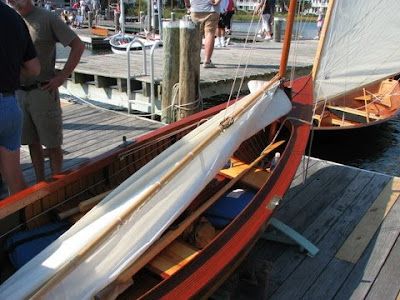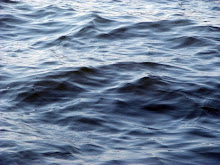 photo courtesy John Armstrong
photo courtesy John ArmstrongBrother John and I made the trip down to St. Michaels, MD last Saturday for the 27th MASCF. Just in the gate and the first attraction was a beautifully crafted West Greenland skin on frame Qayaq. Owner built by Jennie Plummer-Welker, great attention was paid to details, such as holes in the runners for the rib lashing so as to avoid a bumpy skin.
 photo courtesy John Armstrong
photo courtesy John ArmstrongJohn and I then headed straight for the dock where we sighted Silent Maid, which we hadn't expected. We were greeted by prodigious boatbuilders Wendy Byars and John Brady, down from the Independence Seaport Museum in Philly. John runs the museum boatshop, Workshop on the Water and Wendy is a frequent volunteer. Silent Maid was lauched last summer at the museum and has been visiting up and down the East Coast since. My brother also volunteers, in the museum library, and we were soon aboard the Maid, invited for a sail.

John powered us out to the race course just in time for the annual free for all, with what seemed like a hundred small boats of all descriptions, from a Chesapeake log canoe to some very small decked sailing canoes.

An obviously exultant Wendy, (aka Sailorgirl) at the helm. Check out Sailorgirl for Wendy's view of the entire 5 day experience
 One of my crew mates aboard the Maid turned out to be Barry Long of Eye In Hand. He has a huge repository of beautiful images of the last three years at St.Michaels.
One of my crew mates aboard the Maid turned out to be Barry Long of Eye In Hand. He has a huge repository of beautiful images of the last three years at St.Michaels.
Buna Mon Iya, a Crotch Island Pinky designed and built by Peter Van Dine and owned and sailed by George and Marla Surgent.

John Allen on his 16/30 racing canoe. The design dates from the glory days of canoe racing very early 20th C. Many of the 16/30's were hard chine, as this appears to be.

Later in the day John heads back out for more. These boats developed in the Lake Ontario region and were considered the setup for canoe racing by their devotees. A revival of the design has been spurred by research and development at the Antique Boat Museum in Clayton, NY.

Timm Schlieff sailing his Nat Herresoff designed Coquina in the race. You can just see the committee boat behind him.

Later, near the dock. Timm builds boats professionally in West Virginia. The Coquina was Capt'n Nat's favorite boat and he sailed here summer and winter in Marblehead.

Ahoy, Two Keys! Ships boat (replica) for the Kalmar Nyckel, Delawares tall ship. She's a period shallop and sports a small cannon, which may have been the starting gun for this race.

Nice big Swedish standard. Kalmar Nyckel brought the first Swedish settlers to America and sailed up the Delaware River to New Sweden in 1638. New Sweden is today known as Wilmington, DE.

I have a soft spot for decked sailing canoes and the day brought me into close proximity of two of the finest I've seen, brought down by a northern contingent.

This is Apple Pie, built by Dave Kavner and Dan Sutherland, and owned by Dave. Both of these characters were also involved n the 16/30 revival mentioned above. Here's a shot of the rudder designed and built by the third member of this triumvirate,

Bob Lavertue, mastermind behind the Springfield Fan & Centerboard Co., maker of finely crafted metal bits and pieces, including the bronze folding fan centerboards installed on both boats. Bobs work is unequaled and he supplies metal parts for sailing canoes with vintage design and a level of craftsmanship worthy of the Victorian originals.

As you can see on his 18' Pretty Jane, built by Will Clements. Both Apple Pie and Pretty Jane are built to JH Rushton designs. Rushton was the pre-eminent canoe builder in Victorian NY and if these boats interest you Atwood Manley's book is a must.

One of the things I was most keen on for this day was meeting Steve and Bruce and Spartina, above. I was hoping for a sail aboard Spartina, a John Welsford Pathfinder built by Steve Earley. Unfortunately I did not manage to track them down until rather late in the afternoon and too late for a sail. Oh well.

Bruce and Steve trailed the boat from Steve's home in Chesapeake, VA to Crisfield MD where they launched and set out on a multiple day tour of the bay with stops designed to sample some of the bays best crabhouses and other attractions. Steve reports that they encountered up to 27 knot winds and made 7.5 knots surfing 3' swells and never felt in any peril. John Welsford's Pathfinder has it's roots in the English Coble's and all his designs are known to be extraordinarily seaworthy. Steve and Bruce have an exemplary weblog wherein they chronicle their many adventures, here.

The CBMM has an active apprenticeship program where volunteers can learn and apply boatbuilding skills. Here's an example. The boatshed is open to museum visitors, and apprentices can explain their work toless knowledgeable visitors.

Apprentice Brooke Harwood explaining bevel and gain in the building of this Delaware Ducker to John and myself.
 She is being built in the traditional lapstrake manner, with copper nails visible. In this photo Brooke is adding a plank.
She is being built in the traditional lapstrake manner, with copper nails visible. In this photo Brooke is adding a plank.
Dubbed the small boat house , this stunning open shed houses Chesapeake workboats in various stages of decay and disrepair. Most of the boats here have placards describing them, but I was unable to locate one for this darling. Less of a morgue, more a sanctuary, this room is calm and contemplative. If I was more of a scholar I could relate what type boat this is, I would guess an oyster boat, but does it really matter? Her beauty shines through the decay.
 A Northumbrian Coble owner built by Robert Slack to a design by Paul Selway, the boat is a modern adaptation of a traditional British workboat and exhibits the distinctive powderhorn sheer of the originals. Meaning a sheerline which incorporates both convex and concave curves. Robert had just moved his boat and unfortunately caught the mast on a tree branch above and injured the mast step, which he'll now have to rebuild! Robert reports that Paul fisher has drawn a larger version, 17' or so, but it has yet to appear on the website. Soon, I am told.
A Northumbrian Coble owner built by Robert Slack to a design by Paul Selway, the boat is a modern adaptation of a traditional British workboat and exhibits the distinctive powderhorn sheer of the originals. Meaning a sheerline which incorporates both convex and concave curves. Robert had just moved his boat and unfortunately caught the mast on a tree branch above and injured the mast step, which he'll now have to rebuild! Robert reports that Paul fisher has drawn a larger version, 17' or so, but it has yet to appear on the website. Soon, I am told.A Penguin!

The Penguin was designed by Phillip Rhodes in 1938 and featured in Yachting Monthly in 1940 after which the class took off. Penguin is designed for amateur construction in plywood and is still racing with a viable and enthusiastic following.




















2.JPG)





















4 comments:
Looks like it was a great event!
Nice report Thomas. It's been on my list for the past umpteen years but never manqaged to get there.
Sjogin awaits: when are you coming down?
Russ
The thing about these loose footed sails - so rare on standard small craft these days - is that they are so manageable and even better they have so much lift. If you haven't experienced 'lift' in a sail, and it's not sewn into 'normal' Bermudan rigs you may not know what you're missing. It's the same with not using gaff or gunter rigs. So much is invested in that tight leading edge on the Bermudan that it's become rare for most sailors to know the advantage of having a spar at the top of your main and a shorter mast - especially when there are contrary squalls about and you need to get a sail up and down fast. (I commneted earlier on the wrong item. Please delete. S)
mmmm! beautiful photos!
Post a Comment